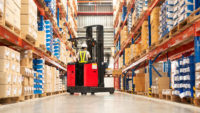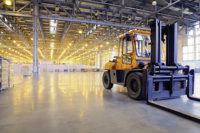Powered Industrial Trucks (1910.178) was the seventh most-frequently cited agency standard in FY 2019.
Enforcement citations FY 2019: 2,113
Number of inspections: 1,461
Proposed penalties: $6,434,380
Most frequently cited industries:
Employers in the Fabricated Metal Product Manufacturing industry were cited 235 times, based on 170 inspections, with proposed penalties of $506,594. In second place: Merchant Wholesalers, Durable Goods, with 195 citations, 130 inspections and $651,617 in penalties. Warehousing and Storage had 167 citations, 113 inspections and $605,928 in penalties. In fourth place was Specialty Trade Contractors, with 160 citations, 144 inspections and $349,031 in penalties. Merchant Wholesalers, Nondurable Goods facilities were inspected 69 times, resulting in 116 citations and $700,446 in penalties.
Nonmetallic Mineral Product Manufacturing companies earned 108 citations from 69 inspection, with $217,936 in penalties. Wood Product Manufacturing had 78 citations, 60 inspections and $165,068 in penalties. There were 45 inspections of Plastics and Rubber Products Manufacturing
Workplaces, resulting in 73 citations and $249,226 in proposed penalties. Food Manufacturing employers were cited 64 times, inspected 44 times and had $179,530 in penalties. In the Machinery Manufacturing industry, there were 42 inspections, 62 citations and $173,046 in penalties.
What are powered industrial trucks?
Powered industrial trucks, commonly called forklifts or lift trucks, are used in many industries, primarily to move materials. They can also be used to raise, lower, or remove large objects or a number of smaller objects on pallets or in boxes, crates, or other containers. Powered industrial trucks can either be ridden by the operator or controlled by a walking operator. Over-the-road haulage trucks and earth-moving equipment that has been modified to accept forks are not considered powered industrial trucks.1
Hazards
Different types of powered industrial truck present different operating hazards. For example, a sit-down, counterbalanced high-lift rider truck is more likely than a motorized hand truck to be involved in a falling load accident because the sit-down rider truck can lift a load much higher than a hand truck. Workplace type and conditions are also factors in hazards commonly associated with powered industrial trucks. For example, retail establishments often face greater challenges than other worksites in maintaining pedestrian safety. Beyond that, many workers can also be injured when (1) lift trucks are inadvertently driven off loading docks; (2) lifts fall between docks and an unsecured trailer; (3) they are struck by a lift truck; or (4) they fall while on elevated pallets and tines.1
Key provisions
All new powered industrial trucks (except for vehicles intended primarily for earth moving or over-the-road hauling) must meet the design and construction requirements established in the "American National Standard for Powered Industrial Trucks, Part II, ANSI B56.1-1969," – and have to have a label on them indicating approval by the testing laboratory.
Modifications and additions which affect capacity and safe operation can’t be made without manufacturer’s prior written approval.
If the truck is equipped with front-end attachments other than factory installed attachments, the user shall request that the truck be marked to identify the attachments and show the approximate weight of the truck and attachment combination at maximum elevation with load laterally centered.
A number of provisions allow specially-equipped trucks powered industrial trucks to be used in locations where that type of trucks is not usually considered suitable. These include:
- Diesel-powered units that have additional safeguards to the exhaust, fuel and electrical systems electrically powered units that, in addition to all of the requirements for that type of unit, are provided with additional safeguards to the electrical system to prevent emission of hazardous sparks and to limit surface temperatures
- Gasoline-powered units with additional safeguards to the exhaust, fuel, and electrical systems and liquefied petroleum gas powered units that are provided with additional safeguards to the exhaust, fuel, and electrical system
Power-operated industrial trucks cannot be used in a number of atmospheres, including those containing hazardous concentration of acetylene, butadiene, ethylene oxide, hydrogen (or gases or vapors equivalent in hazard to hydrogen, such as manufactured gas), propylene oxide, acetaldehyde, cyclopropane, diethyl ether, ethylene, isoprene, or unsymmetrical dimethyl hydrazine (UDMH); in atmospheres containing hazardous concentrations of metal dust, including aluminum, magnesium, and their commercial alloys, other metals of similarly hazardous characteristics, or in atmospheres containing carbon black, coal or coke dust (except approved power-operated industrial trucks designated as EX).
In atmospheres where dust of magnesium, aluminum or aluminum bronze may be present, the fuses, switches, motor controllers, and circuit breakers of trucks must have enclosures specifically approved for such locations.
Reducing the hazards
Determining the best way to protect workers from injury largely depends on the type of truck operated and the worksite where it is being used. Employers must ensure that each powered industrial truck operator is competent to operate a powered industrial truck safely, as demonstrated by the successful completion of the training and evaluation specified in 29 CFR 1910.178(l)(1).
Forklift operators must follow safe operating rules at all times. This includes maintaining control of the forklift, keeping a proper lookout and operating the vehicle at speeds that are safe for the particular operation and worksite conditions and enable them to stop in time to avoid tip-overs and collisions with pedestrians and obstacles. Best practices also include:
- When changing direction, operators should complete stop.
- When reversing, a horn or warning light should be used to alert pedestrians to the movement.
- When traveling on inclines, loaded trucks should be driven forward going up a ramp with the load upgrade and in reverse going down a ramp with the load upgrade. Always drive unloaded trucks with the forks downgrade. Never turn a forklift on a grade.
- Unattended vehicles should be properly secured.
- Operators should take measures to minimize the risks involved with impaired visibility, which can result in a falling load, falling off a loading dock or a worker being struck or crushed by a forklift.
References
|
2020 Top Standards Article Index ANSI/ISEA 121- Dropped object prevention solutions NFPA 652 standard on fundamentals of combustible dust OSHA most frequently violated standardsFall protection- General Requirements (1926.501) Hazard Communication (1910.1200) The Control of Hazardous Energy (Lockout/Tagout) 1910.147 Respiratory Protection (1910.134) Powered Industrial Trucks (1910.178) |



